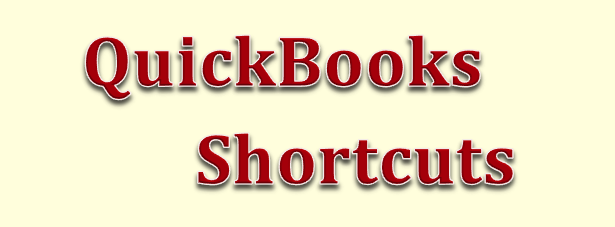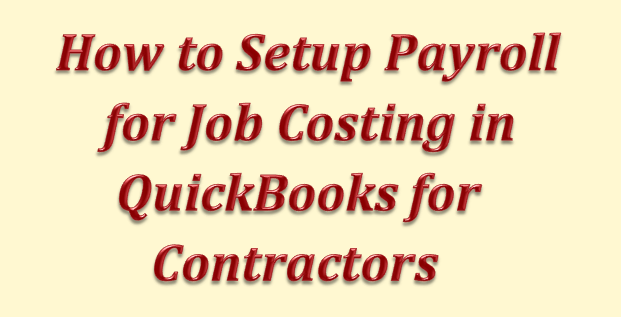by Marie | Aug 27, 2016 | QuickBooks Essentials, Resources

Using QuickBooks Desktop Shortcuts can really help to make life using QuickBooks easier. Here is a list to familiarize yourself with:
Opening & Closing QuickBooks:
| Ctrl |
Start QuickBooks without opening a file. This is useful if you are having problems with the last company file you were using – and you want to start with the Open or Restore Company window |
| Alt |
Start QuickBooks without all the windows. If you have your desktop set to remember what windows you have open, sometimes it takes a VERY long time to start QuickBooks. This option will start it without opening all the windows |
| Alt+F4 |
Close QuickBooks |
Date Shortcuts:
| + |
(plus key) Advance to the next day |
| - |
(minus key) Previous day |
| T |
Today |
| W |
First day of the week |
| K |
Last day of the week |
| M |
First day of the month |
| H |
Last day of the month |
| Y |
First day of the year |
| R |
Last day of the year |
| [ |
(left bracket) Same day in previous week |
| ] |
(right bracket) Same day in next week |
| ; |
(semi colon) Same date last month |
| ‘ |
(apostrophe) Same date next month |
| Alt+down arrow |
Opens the calendar for date selection (the small date calendar, not the “Calendar” feature) |
Editing QuickBooks Transactions & Lists:
| Ctrl+Del |
Delete the selected line in a transaction |
| Ctrl+Ins |
Insert a blank detail line in a transaction |
| Ctrl+N |
Create a new transaction or list item |
| Ctrl+D |
Delete the current transaction or list item. Please note that you cannot reverse this once done |
| Ctrl+E |
Edit an item in an item list, or in a register |
| Ctrl+O |
If you are looking at a check in the write checks window, or in the check register, use ctrl-O to copy the check. You can then use ctrl-V to create (paste) a copy of that check if you are in the check register |
| F5 |
Refresh List. You only see this if you are in multi-user mode, when you have a “list” open. This will force QuickBooks to go back to the database server and retrieve the latest copy of the list. If multiple users are editing the list this may be useful. Note that all lists that are open at the time should be refreshed. |
QuickBooks Windows & Lists:
| Ctrl+W |
Opens the write check window to write a new check |
| Ctrl+Q |
Open a Quick Report for a list item when you have selected the item in the list |
| Ctrl+Y |
Open a transaction journal for a transaction, if you are viewing the transaction |
| Ctrl+J |
Open the customer center |
| Ctrl+A |
Open the Chart of Accounts |
| Ctrl+I |
Open the create invoice window to create a new invoice |
| Ctrl+L |
Open a list – if the cursor is in a field that has a dropdown list, such as selecting the item in an invoice detail line, this will open the list associated with that dropdown |
| Ctrl+U |
Use the list item if you have just used ctrl-L to open the list from a transaction. This is a very useful feature that many people aren’t familiar with. See a more detailed explanation in my article on Improved List Selection |
| Ctrl+R |
Most transactions have a register associated with them. This opens the register for the transaction you are looking at |
| Ctrl+G |
This is an odd one I’m still figuring out. If you are in a registerfor an account, entering ctrl-G will take you to the register for the “transfer” account associated with the line you have selected |
| Ctrl+F |
Opens the find window for the list or transaction type you are working with. This is the old-style Find, not the new Searchfeature (F3) |
| F1 |
Opens the Help window |
| F2 |
Displays the Product Information window, which has a large amount of information that can be very helpful when diagnosing problems in QuickBooks (Ctrl-1 is an alternate) |
| F3 |
Starting with the 2011 version, this opens the newer Searchfeature (as opposed to the Find feature) |
| F3 |
If you have the Product Information window open (by pressingF2), pressing F3 here will open the tech help window. This provides a wide range of system and diagnostic information, as well as being a quick way to view (and possibly edit, if you are careful) a number of support and technical files that relate to QuickBooks operations (Ctrl-2 is an alternate) |
| F4 |
This opens the QuickBooks Technical Support Helper window |
| Ctrl+1 |
This does the same as F2, opening the Product Informationwindow |
| Esc |
Close the current window |
| Ctrl+F4 |
Close the current window (same as Esc) |
| Ctrl+F6 |
Move to the next open window and make it active. NOTE that for some reason SOME windows don’t allow this, such as theAccountant Center (thank you Mary Longacre for pointing that out) |
| Ctrl+Tab |
Same as Ctrl-F6, moves to the next open window |
| Ctrl+H |
Open the Transaction history – if you have a transaction like an invoice, which has payments applied to it, the transaction history can be very useful |
QuickBooks Maneuvering:
| + |
(plus key) Increase a number in a form, such as a check number or invoice number |
| - |
(minus key) Decrease a number in a form, such as a check number or invoice number |
| Alt+S |
Save the current transaction |
| Alt+N |
Save the current transaction and go to the next |
| Alt+P |
Go to the previous transaction |
| Tab |
Go to the next field |
| Shift+Tab |
Go to the prior field |
| Up Arrow |
Go to the previous line in a form |
| Down Arrow |
Go to the next line in a form |
| Page Up |
Move to a previous page in a form area or report |
| Page Down |
Move to the next page in a form area or report |
| Ctrl+Page Up |
Move to the first item in a list or register |
| Ctrl+Page Down |
Move to the last item in a list or register |
| Enter |
If you are viewing a report this will “quick zoom” – open a register or detailed report. In other windows this will often select the highlighted button/operation |
| Ctrl+Enter |
Record (save) the current record. If you have several buttons at the bottom of a transaction window (like “Save & Close”, “Save & New”, “Clear” and so forth) then Ctrl-Enter will select the best “save” option available. Enter will select the button that is highlighted, which might not be the best “save” option |
Memorized Transactions:
| Ctrl+M |
Memorize the current transaction. This opens the memorize transaction window |
| Ctrl+T |
Create a new transaction from a memorized transaction. This opens the memorized transaction list |
Miscellaneous Shortcuts:
| Ctrl+P |
Print |
| Ctrl+R+P |
If you have been trying to register QuickBooks, and you have been given a “validation code”, you can easily get to the registration window where it asks you for this code without having to go through all the normal steps for registration. Open QuickBooks, select Help and then About QuickBooks.When the product splash screen shows, press Ctrl-R-P (hold the Ctrl key down then press R and P in succession). This opens the window that lets you enter your validation code |
Standard Text Editing:
| Ctrl+Z |
Undo typing or changes made in field |
| Ctrl+X |
Cut (copy the selected text to the clipboard and remove it from the field). |
| Ctrl+C |
Copy the selected text to the clipboard |
| Ctrl+V |
Paste text from the clipboard to the field |
| Del |
Delete a character to the right |
| Backspace |
Delete a character to the left |
| Home |
Go to the first character in the field |
| End |
Go to the last character in the field |
| Ctrl+Right Arrow |
Move to the next word in a current text field |
| Ctrl+Left Arrow |
Move to the previous word in a current text field |
As with anything else, the more you use them, the better you will get at using them.
RELATED: QuickBooks Online Shortcuts + Michelle Long’s One Click Trick
by Marie | Aug 25, 2016 | Bookkeeping 101, Chart of Accounts Setup & Management, QuickBooks for Mac, QuickBooks for Windows, QuickBooks Online
Cost of Goods Sold are those costs that are directly associated with the production of a good or goods, or with direct service that leads to a sale. Expenses are all the other costs that are not COGS. See list of COGS and Expenses below:
Cost of Goods Sold Accounts
- Blueprints and Reproduction: Blueprints, photostats, and other printing expense
- Bond Expense: Construction bonds expenses directly related to jobs
- Construction Materials Costs: Construction materials costs
- Contracted Services: Direct labor costs for contract (non-employees) performing services for clients
- Equipment Rental for Jobs: Rent paid for rented equipment used on jobs
- Freight and Shipping Costs: Freight-in and shipping costs for delivery to customers
- Freight Costs: Costs of freight and delivery for merchandise purchased
- Job Materials Purchased: Construction materials used on jobs
- Linens and Lodging Supplies: Costs of linens and other supplies for guest rooms
- Materials Costs: Cost of materials used on jobs
- Media Purchased for Clients: Print, TV, radio, and other media purchased for clients
- Merchant Account Fees: Credit card merchant account discount fees, transaction fees, and related costs
- Other Construction Costs: Other costs directly related to jobs such as waste disposal, onsite storage rental, etc.
- Other Job Related Costs: Other costs directly related to jobs such as waste disposal, onsite storage rental, etc.
- Parts Purchases: Purchases of parts for use on customer repairs or resale
- Purchases – Hardware for Resale: Purchases of hardware items for resale that are not tracked or counted in inventory
- Purchases – Resale Items: Purchases of items for resale that are not tracked or counted in inventory
- Purchases – Software for Resale: Purchases of software items for resale that are not tracked or counted in inventory
- Subcontracted Services: Subcontracted services for customer service orders
- Subcontractors Expense: Subcontracted services performed by other contractors
- Tools and Small Equipment: Purchases of tools or small equipment used on jobs
- Worker’s Compensation Insurance: Worker’s compensation insurance premiums
Expense Accounts
- Advertising and Promotion: Advertising, marketing, graphic design, and other promotional expenses
- Auto and Truck Expenses: Fuel, oil, repairs, and other maintenance for business autos and trucks
- Automobile Expense: Fuel, oil, repairs, and other automobile maintenance for business autos
- Bank Service Charges: Bank account service fees, bad check charges and other bank fees
- Business Licenses and Permits: Business licenses, permits, and other business-related fees
- Car and Truck Expenses: Fuel, oil, repairs, and other car and truck maintenance
- Chemicals Purchased: Costs of chemicals used in farming operations
- Computer and Internet Expenses: Computer supplies, off-the-shelf software, online fees, and other computer or internet related expenses
- Continuing Education: Seminars, educational expenses and employee development, not including travel
- Depreciation Expense: Depreciation on equipment, buildings and improvementsDues and Subscriptions: Subscriptions and membership dues for civic, service, professional, trade organizations
- Equipment Rental: Rent paid for rented equipment used for business
- Fertilizers and Lime: Fertilizers and lime purchased for farm operations
- Freight and Trucking: Amounts paid for freight or trucking of farm products
- Gasoline, Fuel and Oil: Gasoline, fuel or oil used for farm machinery
- Insurance Expense: Insurance expenses
- Insurance Expense: General Liability Insurance: General liability insurance premiums
- Insurance Expense: Life and Disability Insurance: Employee life and disability insurance premiums
- Insurance Expense: Professional Liability: Professional liability (errors and omissions) insurance
- Insurance Expense: Workers Compensation: Worker’s compensation insurance premiums
- Interest Expense: Interest payments on business loans, credit card balances, or other business debt
- Janitorial Expense: Janitorial expenses and cleaning supplies
- Landscaping and Groundskeeping: Landscape maintenance, gardening, and pool maintenance costs
- Marketing Expense: Advertising, marketing, graphic design, and other promotional expenses for our company
- Meals and Entertainment: Business meals and entertainment expenses, including travel-related meals (may have limited deductibility)
- Office Supplies: Office supplies expense
- Payroll Expenses: Payroll expenses
- Postage and Delivery: Postage, courier, and pickup and delivery services
- Printing and Reproduction: Printing, copies, and other reproduction expenses
- Professional Fees: Payments to attorneys and other professionals for services rendered
- Rent Expense: Rent paid for company offices or other structures used in the business
- Repairs and Maintenance: Incidental repairs and maintenance of business assets that do not add to the value or prolong its life
- Research Services: Research costs including legal library and subscriptions for research services
- Salon Supplies, Linens, Laundry: Costs of supplies used in the course of business (includes linens and laundry services)
- Seeds and Plants Purchased: Seeds and plants purchased for producing farm income
- Shop Expense: Miscellaneous shop supplies and related shop expenses (rags, hand cleaning supplies, etc.)
- Small Tools and Equipment: Purchases of small tools or equipment not classified as fixed assets
- Storage and Warehousing: Amounts paid to store farm commodities
- Taxes – Property: Taxes paid on property owned by the business, franchise taxes, excise taxes, etc.
- Telephone Expense: Telephone and long distance charges, faxing, and other fees Not equipment purchases
- Travel Expense: Business-related travel expenses including airline tickets, taxi fares, hotel and other travel expenses
Uniforms: Uniforms for employees and contractors
- Utilities: Water, electricity, garbage, and other basic utilities expenses
by Marie | Aug 25, 2016 | Invoicing & Receivables, Preferences & Customization

Estimating is not only important for construction companies, but any company that produces Invoices, give quotes, bids, and proposals can use estimates in QuickBooks to get a handle on their job costing. Even if you do not provide your clients with estimates, you need to enter them in order to get the most out of the QuickBooks job costing reports. These reports, especially the “Job Estimates vs. Actuals” reports, are the key to making sure your existing job budgets are on track. They are also important when evaluating the accuracy of your estimates so you can make adjustments for future projects, as well as a requirement if you want to do progress invoice.
Setting Up Estimates in QuickBooks Contractor Edition
- Turn on the Estimate function at Preferences, then Jobs & Estimates.
- Create service items that match your project phases at Lists, Item List. You might also want to create sub-categories for materials and labor for tracking purposes, and use groups (see below) so they do not show up separately on your estimates and invoices.
- Create group items for items that you often sell together, this speeds up data entry and also allows you to hide details on estimates and invoices. For example, you could make a “Cupboards” group by grouping the items for all the materials and labor used. Each item in the Cupboards group has its own cost and selling price. When you choose an item for your estimate or invoice, you simply have to enter a quantity to get the total price for cupboards. You can also choose not to include the detail on your estimates and invoices by not checking the “Print items in group” box.
- Customize your estimates by clicking on the Customize button at the top of the Estimate form, then select Additional Customization.
- You can create multiple estimate forms for different needs and manage them at Lists, Templates.
- You can also memorize completed estimates that you use frequently by going to Edit, Memorize Estimate. You can also duplicate estimates at Edit, Duplicate Invoice.
- You can download free customized estimate templates from Intuit at: http://community.intuit.com/library/forms.
Entering Data for Accurate Reporting
- In order to get detailed estimate vs. actual job costing reports, you need to enter both estimated costs as well as revenue.
- You can either enter a $ or % markup to determine revenue, or you can enter revenue to determine the markup.
- If you want one line item for all revenue, enter $0 in the revenue column and add an additional item line for the revenue with no cost entered.
Linking Estimates with Invoices, Purchase Orders, and Sales Orders
- You can create invoices directly from the estimate by clicking on the Create Invoice button. You can invoice for the entire project or select progress invoicing. For progress invoicing, first turn on the function at Preferences, Jobs & Estimates. Then QuickBooks will give you the option of invoicing either for a fixed percentage of the entire estimate, or for different percentages of each line item on the estimate.
- You can also create sales orders directly from the estimate. First turn on the function at Preferences, Sales & Customers. Once you do, the purchase order button will be hiding under the Create Invoice button (click the down arrow to the right of it to see your options).
- You can also create purchase orders directly from the estimate. First turn on the function at Preferences, Items & Inventory. Once you do, the purchase order button will be hiding under the Create Invoice button (Click the down arrow to the right of it to see your options).
Change Orders & Estimates
A change order function is built into the contractors editions of QuickBooks. If you do not have the contractors edition, you can create new estimates for change orders, but this requires separate invoices. A better option is to create estimate & change order subtotal items and add change order items as separate line items on the original estimate.
by Marie | Aug 25, 2016 | Employee Setup & Management, Payroll Setup & Management, Preferences & Customization

There are several steps needed in order for payroll to flow properly to the job costing reports – especially if you want to include payroll taxes and benefits. The step-by-step instructions below will help guide you through the setup.
You must have a QuickBooks payroll subscription to use these instructions. If you are trying to use job costing with a non-QuickBooks payroll provider, you will not only make your bookkeeping much more time-consuming but also introduce opportunities for errors to be made. QuickBooks offers a complete payroll solution, just like ADP and Paychex, and at a great price too.
Since labor is usually the biggest expense for most companies who are doing job costing, it is vitally important that it be included in your job cost reports. If you don’t include labor, your jobs will seem more profitable than they really are. Even worse, some of them might even be losing money without you even knowing it. This not only affects your present situation, but can lead you to create inaccurate estimates for future jobs.
Here are the steps for setting up payroll for job costing in QuickBooks:
Step 1. Set up Preferences:
- Go to Edit, Preferences, Company Preferences and select Payroll & Employees
- Select “Full Payroll” or “Complete Payroll Customers”
- Check “Job Costing, Class and Item tracking for paycheck expenses”
- Go to Time & Expenses
- Select Yes under “Do you track time?”
- You may also want to check “Create invoices from a list of time & expenses”
Step 2. Set up Payroll Items:
- Go to Lists, Payroll Items
- Next, edit every Addition and Company Contribution item to ensure that “Track expenses by job” is checked
- Payroll items can only be mapped to one expense account, so you may want to setup separate ones for Cost of Goods Sold (COGS) and overhead payroll expense
Step 3. Set up Employee Records:
Step 4. Set up Default for New Employees:
- Go to the Employee Center and select Manage Employee Information, then Change Employee Default Settings
- Check “Use time data to create paychecks”
Step 5. Set up Workers Comp:
- Go to Employees, Workers Compensation, then Setup Workers Comp
- Setup your workers comp codes at Employees, Workers Compensation, then Workers Comp List
- Next, go to Lists, Payroll Items to double-check that the Workers Comp payroll item has “Track expenses by job” checked
Step 6. Using TimeSheets
- Go to Employees, Enter Time, then Use Weekly Timesheet
- Complete all information including both a payroll item & a service item. Mark as billable if you do time & material billing
- You may want to add a customer:job called Overhead, so you will have a place to place other entries in order not to forget to make allocation
- Consider using “Time Tracker” or “WorkTrack Time Card” so employees can enter their own time
RELATED:
by Marie | Aug 24, 2016 | Bookkeeping 101, Chart of Accounts Setup & Management, Deposits & Undeposited Funds, QuickBooks for Mac, QuickBooks for Windows, QuickBooks Online

Tenant security deposits are not income and as such, they are to be held until tenant is giving up lease or given notice to leave. If at this point there are repairs to be done, the cost of the total repairs will be deducted and the remainder of the deposit returned to the tenant.
Here is how you enter tenant security deposits correctly in QuickBooks:
- Create an account in your chart of accounts called Tenant Security Deposit, with its type “Other Current Liability”. To do this: a) Select List from the top menu bar, then Chart of Accounts. b) At bottom left, click on the plus sign (in the mac version) or Account then New (in the Windows version – Pro, Premier, Enterprise). Next:
- Go to Banking, Make Deposits and enter the correct date, the tenant’s name in the “Received From” column, select the liability account you just created in the “From Account” column, and enter the payment type, reference number, memo, and amount of the deposit. Be sure to select the bank account you will deposit the tenant’s security deposit to, at the “Deposit to:” drop down option at top left.
- Click Save, Save and New or Save and Close.
In QuickBooks Online, a) Go to Transactions in the left menu bar, then select Chart of Accounts then New at top right of screen. Next:
- Go to the Plus sign at top center of screen, then select Bank Deposit under “Other”
- Enter the correct date, the tenant’s name in the “Received From” column, select the liability account you just created in the “Account” column, and enter the payment type, reference number, description, and amount of the deposit. Be sure to select the bank account you will deposit the tenant’s security deposit to, at the top left drop down option.
- Click Save and New or Save and Close at bottom right.
Any question(s), please feel free to browse our Frequently Asked Questions categories or drop Marie a note.






Recent Comments